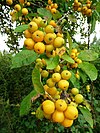Malus fusca
| Malus fusca | |
|---|---|

| |
| Flowers and leaves at Humboldt Bay National Wildlife Refuge in California | |
| Scientific classification | |
| Kingdom: | Plantae |
| Clade: | Tracheophytes |
| Clade: | Angiosperms |
| Clade: | Eudicots |
| Clade: | Rosids |
| Order: | Rosales |
| Family: | Rosaceae |
| Genus: | Malus |
| Species: | M. fusca
|
| Binomial name | |
| Malus fusca (
Raf.) C.K.Schneid. | |
| Synonyms | |
|
Synonymy
| |
Malus fusca, with the common names Oregon crabapple and Pacific crabapple, is a species of
Description
Malus fusca is a
The flowers are white or pale pink, blooming in spring. The fruits are small round apple-shaped pomes, about 2 cm (3⁄4 in) long and from red to yellow-green in colour.[3][4] They may stay on the tree until winter.[5]
The trees can reach at least 100 years of age.[2]
-
Botanical illustration
-
Tree at Royal Botanic Gardens, Kew
-
Leaves
-
Leaf undersides
-
Close-up of flower
-
Fruit
Taxonomy
Archibald Menzies described the species in 1792 after finding it near today's Port Angeles, Washington.[2]
Distribution and habitat
The species can be found from Alaska, through British Columbia, to northwestern California. It grows in temperate coniferous forest, primarily in the Cascade Range and the Pacific Coast Ranges.[6][7][8][9][10]
The tree can grow in a variety of maritime conditions, its rootstock tolerating wet soils (including saltwater estuaries), poorly drained areas and heavy clay soils. It can be found in high-rainfall regions.[11][12]
Ecology
It can be found growing along with
Uses
The oblong fruit can be eaten, but has a sour flavor.[13] The fruit can also be used for extraction of pectin, useful in helping make jams and jellies from other fruits, and is also made into jams and jellies itself.[14] The bark can be used as an herbal medicine. It is also grown in parks and gardens as an ornamental plant.[citation needed]
Pacific crabapple fruits were prized by
The tree was also valued for its tough, resilient wood, used for making implements, and for its bark, used for a wide range of medicinal purposes.[16][17]
References
- ^ Plants for a Future−PFAF: Malus fusca
- ^ OCLC 1141235469.
- ^ Malus fusca'- Árboles ornamentales (in Spanish)
- ^ Flora of North America, Malus fusca (Rafinesque) C. K. Schneider, 1906. Oregon or Western or Pacific crabapple
- ^ "Malus fusca: Western Crabapple". Portland Nursery. Retrieved 2022-08-04.
- ^ Biota of North America Program: 2014 county distribution map
- ^ Biota of North America Program 2014 state-level distribution map
- ^ Calflora taxon report, University of California, Malus fusca (Raf.) C. Schneider Oregon crab apple, Oregon crabapple
- ^ University of Washington, Burke Museum
- ^ Biodiversity of the Central Coast: Pacific Crab Apple
- ^ Deur Keeping it Living. University of Washington Press, 2005, p. 13.
- ^ "Pacific Crabapple Project". Northwest Meadowscapes. October 29, 2017. Retrieved 2022-11-03.
- ^ ISBN 0394507614.
- Bonanza Books. p. 506.
- ^ University of Michigan at Dearborn: Native American Ethnobotany of Malus fusca (Oregon Crabapple)
- ^ Deur, Douglas and Turner, Nancy J. Keeping it Living. University of Washington Press, 2005, p. 13.
- ^ Crabapples - University of Alaska Fairbanks description, photos, recipes








